OCZ ARC 100 (240GB) SSD Review
by Kristian Vättö on August 26, 2014 7:00 AM ESTRandom Read/Write Speed
The four corners of SSD performance are as follows: random read, random write, sequential read and sequential write speed. Random accesses are generally small in size, while sequential accesses tend to be larger and thus we have the four Iometer tests we use in all of our reviews.
Our first test writes 4KB in a completely random pattern over an 8GB space of the drive to simulate the sort of random access that you'd see on an OS drive (even this is more stressful than a normal desktop user would see). We perform three concurrent IOs and run the test for 3 minutes. The results reported are in average MB/s over the entire time.
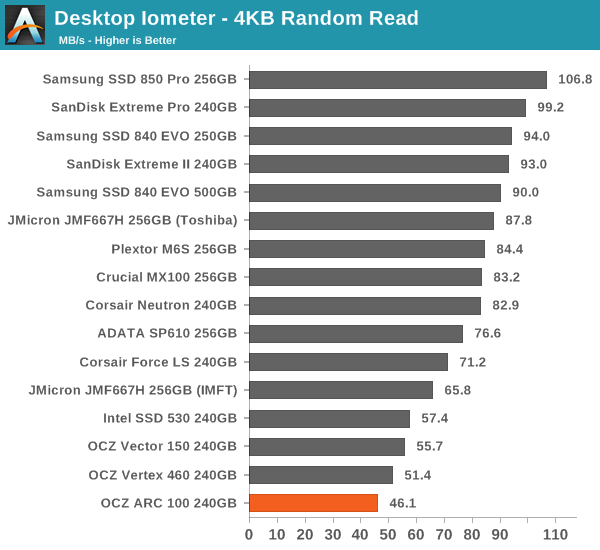
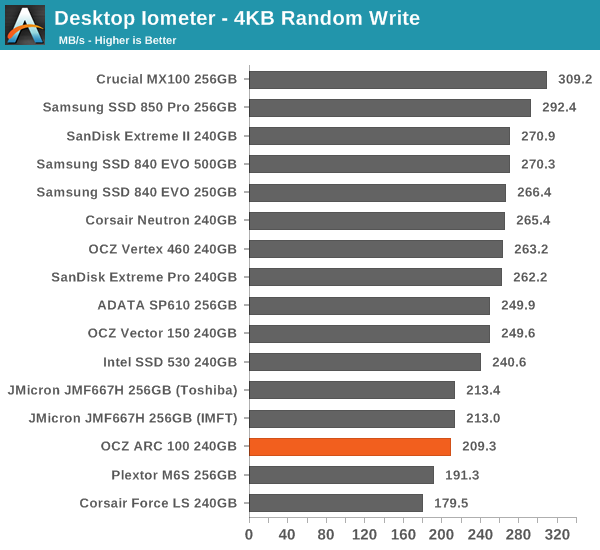
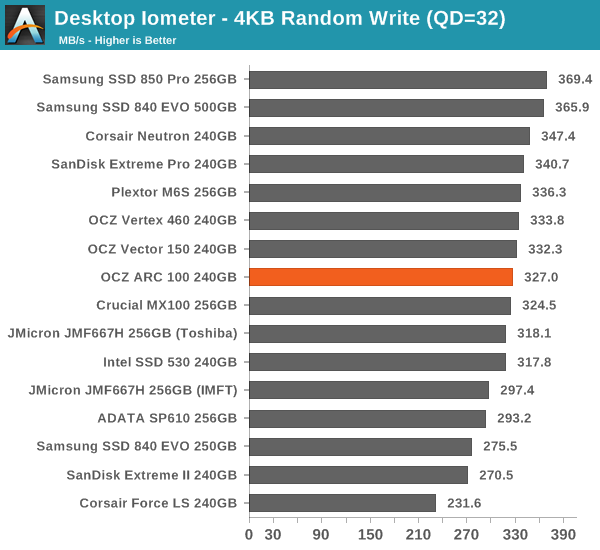
Random speeds show a small decrease in performance over the other OCZ drives, which is due to the combination of the slower M10 controller and A19nm NAND.
Sequential Read/Write Speed
To measure sequential performance we run a 1 minute long 128KB sequential test over the entire span of the drive at a queue depth of 1. The results reported are in average MB/s over the entire test length.
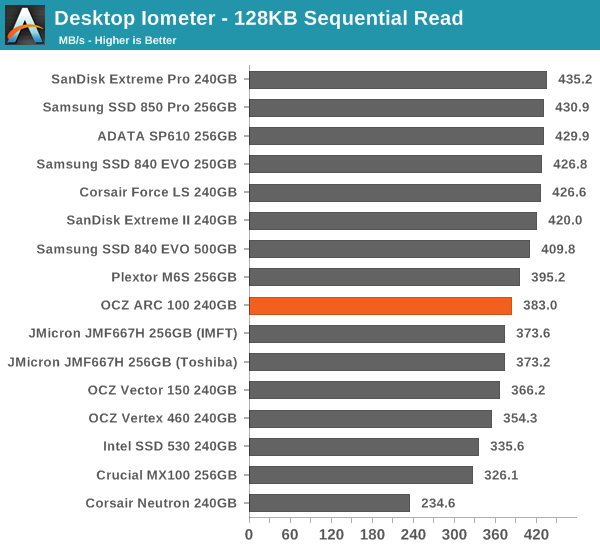
In sequential performance the ARC 100 seems to be more optimized for read performance as that is up compared to the Vector 150 and Vertex 460, but in turn the write speed has decreased slightly.
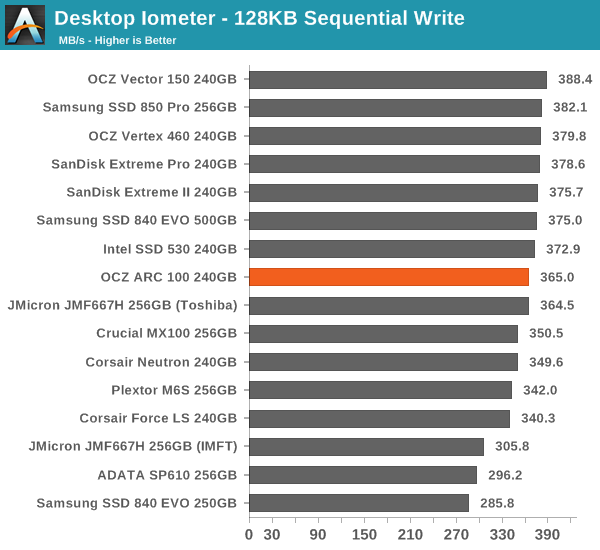
AS-SSD Incompressible Sequential Read/Write Performance
The AS-SSD sequential benchmark uses incompressible data for all of its transfers. The result is a pretty big reduction in sequential write speed on SandForce based controllers, but most other controllers are unaffected.
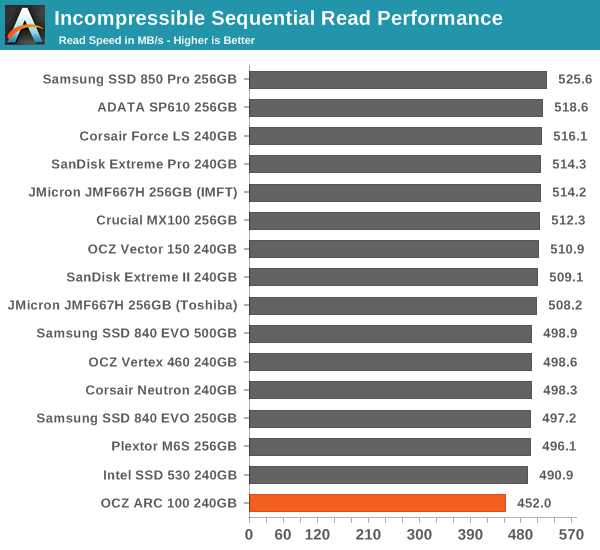











54 Comments
View All Comments
blackmagnum - Tuesday, August 26, 2014 - link
I'd rather have the cheaper/faster SanDisk Extreme II and its 10-year warranty.Lonyo - Tuesday, August 26, 2014 - link
10 year warranty doesn't mean much. In 5 years, if it dies you would probably just replace it with something far faster and cheaper. The warranty doesn't get you your data back, it just gets you a replacement drive.After 3 years you might like a replacement drive, but much more than that and it becomes pretty meaningless to get a replacement slow/old drive considering how quickly SSDs have advanced. A 10 year warranty is pretty meaningless for this type of product, which is probably why Sandisk are happy to offer it. It gives false peace of mind and they know most people wouldn't take them up on it.
FunBunny2 - Tuesday, August 26, 2014 - link
-- but much more than that and it becomes pretty meaningless to get a replacement slow/old drive considering how quickly SSDs have advancedWe got the Great Recession because Bankster asserted that home prices, which had been exponentially rising, would do so forever. We're near, if not at, the asymptotic limit of node, esp. for NAND. Controller logic & error correction can do only so much.
If the industry can invent a smaller, non-destructive written, piece of memory (which responds to current semi-conductor logic) then may be. But, were I to be betting, I'd bet that consumer SSD will be only marginally better in 3 years.
Kristian Vättö - Tuesday, August 26, 2014 - link
That is what 3D NAND is for.xenol - Tuesday, August 26, 2014 - link
I'd argue raw bandwidth is really that important considering that RAM disks which is comfortably over 10 times faster than an SSD in terms of bandwidth for sequential and smaller reads still don't offer a huge performance improvement over an SSD that an SSD provides over an HDD (and even then, it's not linear). "Loading" at this point is initialization, and that depends entirely on software.I suppose it'd be nice if we had universal memory, but SSDs are not a good candidate for that.
TheWrongChristian - Tuesday, August 26, 2014 - link
I tell you what, I'd take that bet. With SATA being replaced as the primary interface and 3D NAND, I can easily see peak performance doubling in the next 3 years, and significant improvements in steady state performance.FunBunny2 - Tuesday, August 26, 2014 - link
And what, exactly, will the normal SSD consumer (not an uber-gamer) do with that performance? Would s/he even notice? Will 3D NAND lower the price/byte to spinning rust? I wouldn't bet on that, either. My bet: in 3 years consumer SSD will still be performing "good enough" for Joe Sixpack at about the same price as "good enough" does today. What may be different: PC makers, if there are any left, will ship with an SSD rather than a HDD be default, and those with the need for mass storage will buy one with both.oynaz - Wednesday, August 27, 2014 - link
Performance is not the point - space is. You are correct that SSDs are already so fast that even a doubling ot tripling of perfomance will not make much of a difference.However, they are still too small. 256 Gb just doesn't cut it.
... I am not exactly sure where I am going with this ;-)
Kibbles - Saturday, August 30, 2014 - link
Typical usage patterns change with the technology available.Imagine when VR becomes common place. You'd want things to load almost instantaneously because once the computer experience becomes truly interactive, fast response times are so much more important.
leminlyme - Tuesday, September 2, 2014 - link
I LIKE YOU, AND THE WAY YOU THINK. I must add however, that storage and access is not a bottleneck for 3d environments at the moment. If you had such immense immersive environments that our current storage read times were being the bottleneck, I think 780 ti's would be worth 100$ comparitively.